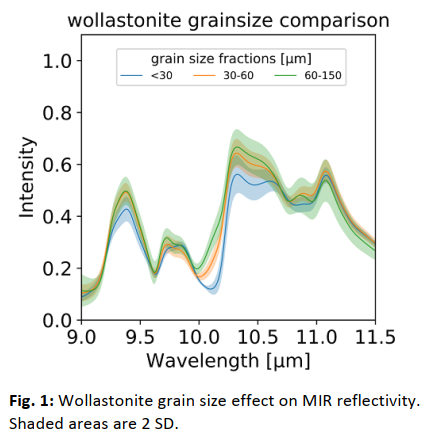Solar wind sputtering on Mercury and the Moon: effects on mid infrared spectra of mineral powder pellet analogues
- 1University of Bern, Physics, Space Research & Planetary Sciences, Bern, Switzerland (noah.jaeggi@space.unibe.ch)
- 2Institute of Applied Physics, TU Wien, Vienna, Austria
- 3Institute of Geological Sciences, University of Bern, Bern, Switzerland
Planet surfaces exposed to high energy plasma undergo surface alteration by sputtering (e.g., [1]). Impinging ions thereby eject particles from the uppermost layers of mineral grains. The effect that sputtering has on surface reflectivity in mid infrared (MIR) is relevant for the interpretation of surface-based spectra as well as future Bepi Colombo MIR spectra. Previous studies have shown that the IR spectrum of a given mixture varies with its porosity, grain size, temperature, emergence angle and mineral to glass ratio [2, 3, 4, 5, 6].
This study uses the mineral diopside (CaMgSi2O6), enstatite (Mg2Si2O6), wollastonite (Ca2Si2O6), and bytownite (Na0.2Ca0.8Al2Si2O8) as analogues for the surfaces of Moon and Mercury. The minerals were ground to flocculation resulting in mean grain sizes of 20-34 µm and then and pressed into pellets with porosities of about 20 %. In addition to bulk powder pellets, wollastonite powder fractions of <30, 30-60 and 60-150 µm were produced and analyzed. Mineral powder pellets were irradiated by He2+ with solar wind characteristic energies of 4 keV under an incident angle of 45°.
Before ion irradiation, MIR spectra show an expected, strong dependence on grain size (Figure 1, e.g., [3]). First results of irradiated wollastonite bulk powder pellets with mean grain sizes of 34 µm are presented in Figure 2. IR reflectivity after irradiation shows changes in relative peak intensities and the apparent loss of peaks. A similar effect was observed when lowering grain size in the non-irradiated samples. These results suggest that solar wind sputtering effects add to the ambiguity for interpreting MIR data of planetary surfaces.

List of References
[1] Pieters, C. M., Noble, S. K. (2016). J. Geophys. Res.-Planet, 121(10), 1865–1884.
[2] Salisbury, J. W., Eastes, J. W. (1985). Icarus, 64(3), 586–588.
[3] Mancarella, F., et al. (2015). Planet. Space Sci., 117, 96–105.
[4] Varatharajan, I., et al. (2019). Earth and Planetary Science Letters, 520, 127–140.
[5] Maturilli, A., et al. (2016). Earth Planets Space, 68(1), 84.
[6] Young, C. L., et al. (2019). Icarus, 321, 71–81.
How to cite: Jäggi, N., Szabo, P. S., Biber, H., Mezger, K., Aumayr, F., Wurz, P., and Galli, A.: Solar wind sputtering on Mercury and the Moon: effects on mid infrared spectra of mineral powder pellet analogues, Europlanet Science Congress 2020, online, 21 September–9 Oct 2020, EPSC2020-179, https://doi.org/10.5194/epsc2020-179, 2020

